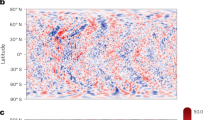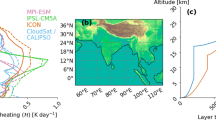Abstract
Mesoscale (<100 km) atmospheric phenomena are ubiquitous on Mars, as revealed by Mars Orbiter Camera images1,2,3. Numerical models provide an important means of investigating martian atmospheric dynamics, for which data availability is limited. But the resolution of general circulation models, which are traditionally used for such research, is not sufficient to resolve mesoscale phenomena4,5,6. To provide better understanding of these relatively small-scale phenomena, mesoscale models have recently been introduced7,8,9. Here we simulate the mesoscale spiral dust cloud observed over the caldera of the volcano Arsia Mons by using the Mars Regional Atmospheric Modelling System. Our simulation uses a hierarchy of nested models with grid sizes ranging from 240 km to 3 km, and reveals that the dust cloud is an indicator of a greater but optically thin thermal circulation that reaches heights of up to 30 km, and transports dust horizontally over thousands of kilometres.
This is a preview of subscription content, access via your institution
Access options
Subscribe to this journal
Receive 51 print issues and online access
$199.00 per year
only $3.90 per issue
Buy this article
- Purchase on Springer Link
- Instant access to full article PDF
Prices may be subject to local taxes which are calculated during checkout




Similar content being viewed by others
Notes
* In this Letter, "(see Supplementary Information)" should have appeared at the end of the third sentence of the third paragraph. At the end of the Letter, the line "Supplementary Information accompanies the paper on Nature’s website (http://www.nature.com/nature)." should have been included.
References
Cantor, B., Malin, M. & Edgett, K. S. Multiyear Mars Orbiter Camera (MOC) observations of repeated Martian weather phenomena during the northern summer season. J. Geophys. Res. 107, 10.1029/2001JE001588 (2002)
Cantor, B. A., James, P. B., Caplinger, M. & Wolff, M. J. Martian dust storms: 1999 Mars Orbiter Camera observations. J. Geophys. Res. 106, 23653–23687 (2002)
Malin, M. C. & Edgett, K. S. Mars Global Surveyor Mars Orbiter Camera: Interplanetary cruise through primary mission. J. Geophys. Res. 106, 23429–23570 (2001)
Haberle, R. M. et al. General circulation model simulations of the Mars Pathfinder atmospheric structure investigation/meteorology data. J. Geophys. Res. 104, 8597–8974 (1999)
Wilson, R. J. & Hamilton, K. Comprehensive model simulation of thermal tides in the Martian atmosphere. J. Atmos. Sci. 53, 1290–1326 (1996)
Forget, F. et al. Improved general circulation models of the Martian atmosphere from the surface to above 80 km. J. Geophys. Res. 104, 24155–24175 (1999)
Rafkin, S. C. R., Haberle, R. M. & Michaels, T. I. The Mars Regional Atmospheric Modeling System (MRAMS): Model description and selected simulations. Icarus 151, 228–256 (2001)
Tyler, D., Barnes, J. R. & Haberle, R. M. Simulation of surface meteorology at the Pathfinder and VL1 sites using a Mars mesoscale model. J. Geophys. Res. 10.1029/2001JE001618 (2002)
Toigo, A. D. & Richardson, M. I. A mesoscale model for the Martian atmosphere. J. Geophys. Res. 107, 10.1029/2001JE001489 (2002)
Pielke, R. A. et al. A comprehensive meteorological modeling system—RAMS. Meteorol. Atmos. Phys. 49, 69–91 (1992)
Murphy, J. R., Haberle, R. M., Toon, O. B. & Pollack, J. B. Martian global dust storms: Zonally symmetric numeric simulations including size-dependent particle transport. J. Geophys. Res. 98, 3197–3220 (1993)
Hunt, G. E., Pickersgill, A. O., James, P. B. & Johnson, G. Some diurnal properties of clouds over the martian volcanoes. Nature 286, 362–364 (1980)
Acknowledgements
We thank Malin Space Science Systems and M. Malin for permitting the use of MOC imagery before release on Planetary Data System. We also thank A. Bridger for comments and suggestions. This work was supported by the NASA Planetary Atmosphere Program, the Mars Data Analysis Program and the Mars Global Surveyor Data Analysis Program.
Author information
Authors and Affiliations
Corresponding author
Ethics declarations
Competing interests
The authors declare that they have no competing financial interests.
Supplementary information
Rights and permissions
About this article
Cite this article
Rafkin, S., Sta. Maria, M. & Michaels, T. Simulation of the atmospheric thermal circulation of a martian volcano using a mesoscale numerical model. Nature 419, 697–699 (2002). https://doi.org/10.1038/nature01114
Received:
Accepted:
Issue Date:
DOI: https://doi.org/10.1038/nature01114
This article is cited by
-
The Mars system revealed by the Martian Moons eXploration mission
Earth, Planets and Space (2022)
-
Meteorological Predictions for Mars 2020 Perseverance Rover Landing Site at Jezero Crater
Space Science Reviews (2020)
-
High-altitude water ice cloud formation on Mars controlled by interplanetary dust particles
Nature Geoscience (2019)
-
Hydrogen escape from Mars enhanced by deep convection in dust storms
Nature Astronomy (2018)
-
Assessment of Environments for Mars Science Laboratory Entry, Descent, and Surface Operations
Space Science Reviews (2012)
Comments
By submitting a comment you agree to abide by our Terms and Community Guidelines. If you find something abusive or that does not comply with our terms or guidelines please flag it as inappropriate.



